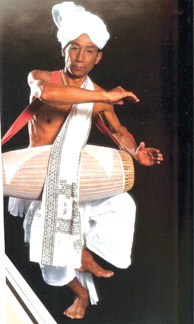Comparative study on Indian classical dance forms
Subashini PATHMANATHAN
Essential elements of classical dance
*Santhi Koothu consists of Chokam, Mei
Koothu, Abinaya and Nadakam
*Mei Koothu consists of Desi, Vaduku and
Sinhalam
*These dance forms enjoyed royal patronage
*Bharatha Natyam has moved to publc halls
from temples
* Most Indian classical dance forms are
based on Natya Sastra
India and Sri Lanka are closely bound by historical, geographical,
cultural and religious ties. Even languages and formation of letters
resemble each other to some extent. Silapathikaram, the Tamil classic,
describes Santhi Koothu which consists of four main Koothu forms:
Chokam, Mei Koothu, Abinaya and Nadakam. Chokam is the pure Nirtha
dance.
 |
|
Manipuri
male drum dancer |
 |
|
Pantheru
and Udekki dancers |
The Mei Koothu consists of three main categories: Desi, Vaduku and
Sinhalam. Desi was a dance form belonging to a Tamil country. Vaduku was
a dance form belonging to Telugu Desam, and the word Sinhalam was
apparently a reference to a dance form belonging to Sinhala country.
Unfortunately, apart from the word Sinhala, there is nothing about the
dance form in Silapathikaram. Even the great Tamil poet Subramaniya
Bharathi spoke of constructing a bridge to Sinhala Deepa.
Traditional Kandyan dance is a pure Nirtha dance firmly based on
Thala, Laya and Thandava Karana stance based on rhythm. Like Bharatha
Natyam, Kandyan Dance was also danced in temples and temple festivals.
But both these dance forms enjoyed royal patronage.
Today Bharatha Natyam has moved to public halls from temples. Kandyan
dance is still danced in temple peraheras (processions), and sometimes
in social functions. In ancient times Sathir was performed in temple
processions. According to early evidence a dance form called Gegge
Natuma, the dance of Devalaya, existed like Sathir. But today Degge
Natuma is no longer in existence, like Sathir. In Bharatha Natyam many
items have disappeared in the course of time but today all that remains
are the references found in literary works.
Most Indian classical dance forms are based on Natya Sastra. But
those dances were developed and influenced by regional, religious,
cultural and social traditions of each region. Kandyan dance also seems
to have been grown out of Natya Sastra, as there are discernible
similarities among classical dance forms of India.
In Bharatha Natyam the term Adavu (a pure nirtha) is confined to a
step (a footwork), a body movement accompanied with a hand movement and
hand Mudras (hastas) based on a particular thala and laya. In Kandyan
dance the term Adavu is used for a collection of pure nirtha movements.
According to Dr Ragavan, “the most alluring of Kandyan dance is the
Ves’. Dr Ragavan also points out “Among these are features which point
to a certain affinity in the Ves dancer’s costumes, to the highly
ornamental and elaborate make up of the dancer in Kathakali of Kerala.”
There are many links between Kandyan and Kathakali dances.
Vannam, one of the Kandyan dances, is the latest inclusion in the
dance. There are altogether 18 Vannams and each Vannam is based on a
separate theme. The addition of Vannam to Kandyan dance provided a
limited scope for some Nirthiya movements in Kandyan dance.
Like Bharatha Natyam female dancers also play a significant role in
Kandyan dance. Some similarities between Kandyan dance and Bharatha
Natyam are the half sitting position, separation of feet, (the gap
between the two legs are wider in Kandyan dance than the gap between the
two legs in Bharatha Natyam), knee facing two different directions
(right and left), stretching the arms at the shoulder level and neck
movements.
In Bharatha Natyam certain pure classical pieces are seen (Alaripu
and Jetheswaram). But these pieces are anyhow interwoven with classical
Carnatic music, thala, and laya. However, in Kandyan dance pure Nirtha
is interwoven with thala, laya and rhythm.
In Kandyan dance ‘Udekki’ is another important category of dance
which derives its name from the drum named ‘Udekki’. In Bharatha Natyam
also this drum plays an important role because in the division of Sabtha
Thandava and in the 108 Thandavas this drum Udekki is always found in
the hands of Thandava Murthi lord Nataraja. The drum is called in Tamil
Udduku. It is believed that all the creations arise out of the sound of
Udduku, according to Thiru Manthiram ‘thotram thudi thanil’. This Udduku
also plays an important role in Hindu rituals.
Some of the Vannams in Kandyan dance are based on Hindu mythology.
For instance, Bharatha Natyam, Oddisi, Manipuri, Kuchipudi and Kathakali
are deeply devotional and these dances are firmly based on Hindu
mythology.
North Indian classical dance form Kathak has certain affinity between
Kandyan dance. For instance, both these are firmly based on Thala and
Laya and firm Nirtha movements. Both these dance forms have fast and
circular movements.
In Manipuri, an East Indian dance form, male dancers mostly wear
white turban, and they carry drums while dancing, as the male dancers in
as Kandyan dance.
Sri Lanka and India are closely linked with one another from the
prehistorically period; hence both the countries have close ties and
affinity with one another in, social, cultural religion and linguistic
basis.
|



